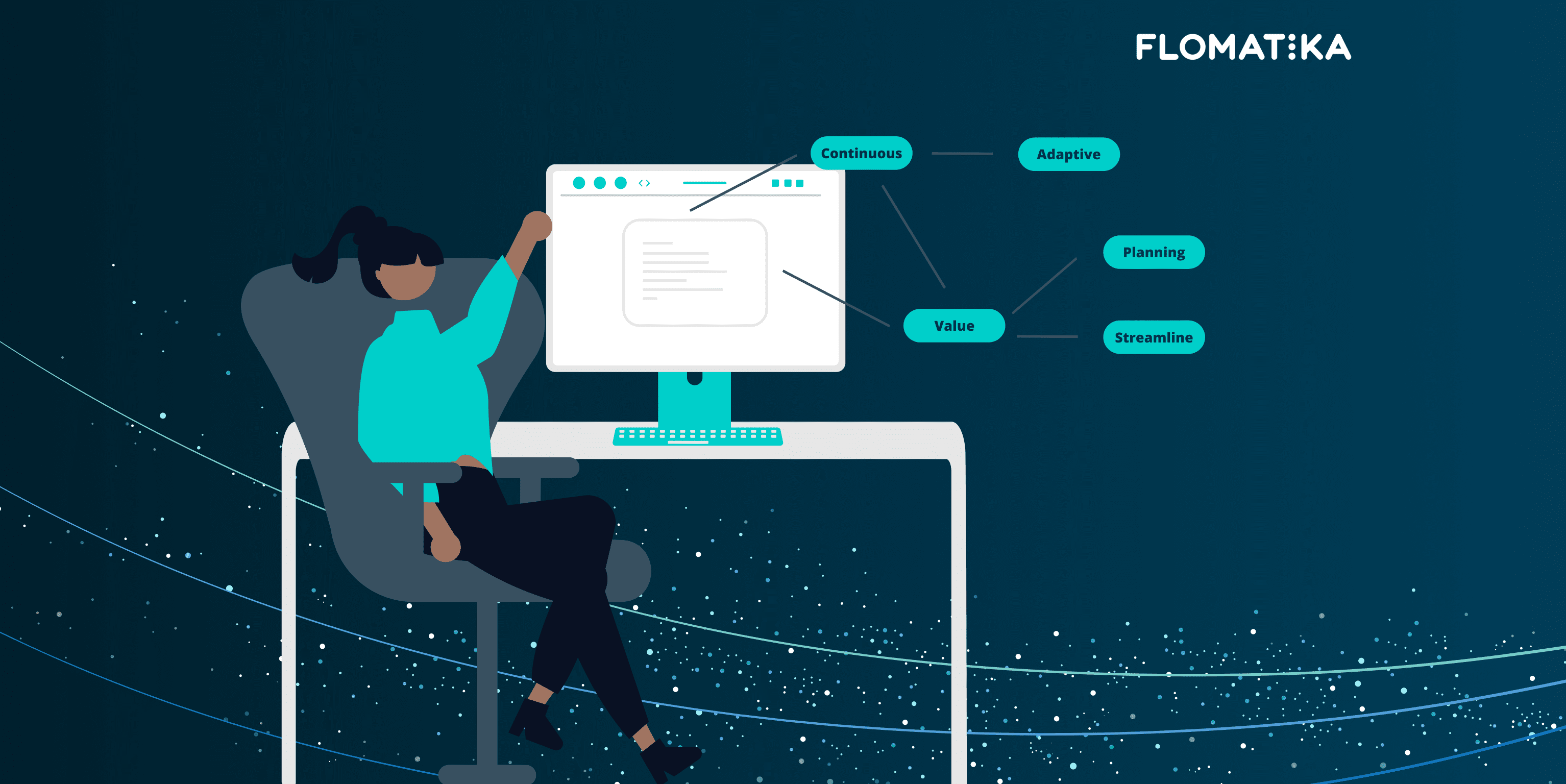So What is a Service Delivery Manager Anyway?

Are you ready to optimise your delivery ecosystem today?
book demoWhat is a SDM?
Name: Service Delivery Manager (SDM for short)
Focus:
- Ensures that work flows efficiently through the system, and that the service is satisfactorily delivered to customers
- Doing things right
- Process efficiency, not necessarily effectiveness
Differentiator: Brings data into the conversation, it's about the work flowing through the system and not about the individuals doing the work
Related Roles: Service Request Manager, Value Stream Manager
Similar Roles: Scrum Master, Delivery Lead, Delivery Manager
So what does an SDM do?
We’re not here to give you the definitive definition of a Service Delivery Manager (SDM). Rather we wanted to share our take on the role. What we’ve observed, how we see it evolving, share our thoughts on what a good SDM looks like, as well as what the role shouldn’t be.
To us, the SDM is focused on the fitness criteria of the service that is being provided. How do they measure against the key criteria that would define if that service is fit for purpose or not. To be able to do this, the SDM needs access to data that brings visibility across these criteria.
Essentially, they need to pay attention to, and ask lots of questions around:
- What's the lead time of the service? Does it align with customer expectations?
- What is the level of productivity?
- What are the levels of predictability?
- What’s the quality of the service being provided?
- Are we putting the sufficient focus on WIP? How much work is in progress right now? What is the age of each of these units of work?
- How is the flow efficiency of the service? Is the work spending a larger portion of its time waiting in queues?
- What is the distribution of demands? Do we have the capacity allocation for the various types of demand? How are the teams respecting those capacity allocations?
- Where are the key sources of delays and waste? Which stage in the workflow do most of the delays reside? How can we reduce or eliminate that queue?
- What are the common causes of the problems impacting the ability of the work to flow through the system?
- How can we do small incremental changes that will improve how that team's operating?
- What is the back-flow and rework in the system? What can we do about it?
Although that’s not an exhaustive list, most of the above can be applied to most services. (Note: If you're starting out as an SDM, you wouldn't necessarily be pursuing all of these initially, but something you might be working towards.)

However, that’s not all a SDM does.They are custodians of the pull policies of the system. What does a piece of work need to have to be able to move to the next step? This applies across each step in their workflow. Once the item has been selected, it's about managing the flow of the delivery system (downstream).
There is also dependency management, which is a big part of the role. Facilitating the conversation across the different subsystems or across the different value stream segments.
They need to facilitate the key sessions such as the Daily Standup, Service Delivery Review, Delivery Planning Meeting, and Retrospectives, whichever session is part of your ways of working.
Ultimately it's focused on the work, not on the people. Facilitating, identifying, analysing, and working towards the resolution of impediments and blockers. Identifying systemic behaviours or patterns. Are there common root causes blocking or slowing down our system? Help the team be able to remove those blockers/impediments.
Managing the flow of the work also involves ensuring the policies of the system are followed. What’s the class of service? Does it navigate through the system via our standard process? Is it a ‘Fixed Date’? When is the last responsible moment for us to tackle that? Is it an ‘Expedite’? Who is able to pick that up and progress it now? What needs to be paused for us to achieve this? They are helping to facilitate and orchestrate in a way that the sequence of work and dependencies fall into place so that that piece of work can be shipped or delivered by the expected delivery date.
Is it a Hat or a Dedicated Role?
From what we’ve seen, much of what an SDM does is done by people playing that role without necessarily having that title, or it being part of their job description. To be able to improve, requires inspecting and adapting, and it’s better to do that with data.
As organisations mature, they may realise how important this role is and recognise that they need a dedicated capacity to focus on it. What perhaps started out as a ‘hat’ worn by team members, might eventually manifest into a dedicated Service Delivery Manager. Alternatively, it becomes part of an existing role: Scrum Master or a Delivery Lead or Delivery Manager or an Agile Coach.
Flomatika for example started with the role as a 'hat' worn by a team member. A number of us took on the responsibilities for a duration, before it was handed to the next team member. Eventually, as the team grew, it became a dedicated Service Delivery Manager. Whose primary focus is understanding how the work is flowing and, then how we can improve process efficiency in hopes that might be a game changer.
What Are Some Key Attributes for a SDM
A Coach
Like many roles, they come in all shapes, sizes and backgrounds. Essentially we see it as a coaching archetype. It's someone that's trying to read the system, get the signals, process the signals, and then nudge the system.
Acting as a reflection mechanism to the system, which often takes the form of asking questions to the team. Do we need to shift a little to the right? Perhaps a bit to the left? Maybe we should put more focus on this? What about that item that seems to have been forgotten? Is that a new expedite demand that has just entered the system?
In knowledge work, the system consists of people. So this person needs to be comfortable dealing with people, acting as a change agent, as actions are how we improve the system.
“I believe that a SDM should have a great rapport with the team - for this, there is excellent communication to absorb and share information in a transparent way that leaves everyone aligned with the expectations that must be met. An SDM [...] I see it as a great process facilitator.“
~ Luiz Reis, Service Delivery Manager at DevMagic
That being said, there are a few different disciplines that can definitely level up whoever is playing that role:
- Understanding of the dynamics of flow-based systems
- Statistics, applying that data lens to be able to read and interpret the data
- Systems Thinking, not just being able to look at the entire system end to end, but also an understanding that there is always a delay between cause and effect
- To a certain extent, economics, as you need to combine all these things together to understand how you're balancing flow, how you're managing flow, the knock-on impacts of the decisions made
Life Long Learner
A good attribute for any role is the constant strive to keep learning. We see people looking to acquire that knowledge through more formal approaches, such as training (Eg Kanban System Design, Kanban Coaching Professional etc). That’s not necessarily the only path. There is so much literature available today to help people up-skill at their own pace, as well as plenty of tools and platforms available that they can get hands-on with.
Unfortunately, we also see people complete the 2-day scrum master training, obtain their badge and believe that’s all they need to be successful in that role. It certainly requires more practical hands-on experience working with products and services as well as applying that data-driven lens. Have at least foundation knowledge around managing flow. What is the lead time? What is the cycle time? What is throughput? How are these things calculated? Why are these things important? What does good look like? How do I interpret what the data is telling me?
Process Manager, not a People Manager
“…One of the dysfunctions [...] we see Scrum Masters today acting as people managers. [...] Approving leave and those sorts of things.“
~ Marcio Sete, CPTO at Flomatika
In principle, a Service Delivery Manager should not be a people manager. It’s really important to understand that SDM is a process manager. They are not there to manage the people, approve leave and the other administrative tasks. Their focus is all on managing the process, and improving process efficiency rather than managing individuals.
Luiz Reis, Service Delivery Manager at DevMagic also agrees.
“I believe that some processes end up being confused - as the SDM can be a great facilitator of the team, there are interpretations where this is the same professional that ends up taking care of people individually, but in fact, he/she should pay attention to the process.”
~ Luiz Reis, Service Delivery Manager at DevMagic
Another facet they should also not be concerned about is what is being delivered. Asking if that item is the right thing to do right now. Does it align with the current strategy? That’s actually a different role. (Refer to an upcoming blog about the Service Request Manager.)
“[SDMs] should not be concerned with what is being delivered.”
~ Marcio Sete, CPTO at Flomatika
A Service Delivery Manager should instead view the units of work as data points in the system. A ‘card’ represents a type of demand that has been selected. Their focus is to ensure it’s moved through the delivery system in a fit-for-purpose manner.
Their lens is on process efficiency, not with effectiveness. That role belongs to the Service Request Manager (SRM). One way to describe it is that the SDM focuses on ‘doing things right’, whereas the SRM focuses on ‘doing the right things’.
“When we talk about process improvements it is natural that some people take the responsibility for themselves, I believe that the SDM should make it clear to everyone that possible failures in the company's goals are the sole responsibility of how the process was conducted and not in "pointing fingers" to the team.“
~ Luiz Reis, Service Delivery Manager at DevMagic
How Does Scrum Fit In?
Something we have observed is that some people see Scrum and Kanban as mutually exclusive approaches. There are plenty of people writing material about how that’s not the case, and that they can complement each other. For us, we can understand why organisations that already have a scrum master dedicated to facilitating the team, it doesn't make sense to get another full-time capacity to focus on the SDM role.
It makes much more sense to skill up the existing person and then make sure that they have everything they need to succeed. Alternatively, it could start as a hat that is shared among the team members. It takes time to build this capability, and both the teams and organisation can evolve this role over time. The SDM role can make a real difference in the outcomes of the group of that service. So having someone skilled up and focus on the role is worth doing.
Emergent Role?
As mentioned earlier, Scrum is the most popular agile framework. As such, the SDM is still a bit of an emerging role. We don't see many of these as dedicated roles. We often see people playing the role, wearing that hat, especially amongst services and delivery teams, but not as a dedicated role.
“The emergence appears to come from this first generation or second generation of Agilists.”
~ Marcio Sete, Flomatika’s CPTO
According to Marcio, these people have been around for a while now and they are maturing and they are applying a flow based lens to how they see things, how they manage, how they help the teams. So this early generation of Agilist are are already applying this lens on top of what they do.
Will we see more SDMs in the future?
As we see organisations, moving from project to products, from projects to value streams, towards long lived-capacity funded teams, from PMO to VMO. The focus will shift from managing projects towards managing value, maximising value. This role is all about overseeing the delivery process, overseeing a fit for purpose service ensuring smooth flow, that things are worked on properly and that there are actions in place to improve that service and the follow up on these actions.
Service Delivery Managers come in all shapes and sizes. In terms of a dedicated role, it seems it’s still emerging, but we see plenty of people wearing the hat. Putting a data lens view of the work, with a focus on the flow of work, and the fitness of the service. To help them in this role, they need access to readily available data, so they can spend more time on gaining the insights, and less time putting the numbers together.
Other blogs you might be interested in:
- How Do Service Deliver Reviews Differ From Retrospectives And Can They Compliment Each Other?
- Service Delivery Review: Speed
- Make better day to day decision by having visibility of your WIP Age % vs SLE











%20(1).jpg)
.jpg)
